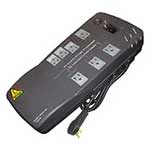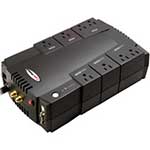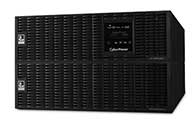We all know that UPS systems are used to power equipment when the power is temporarily interrupted, but different UPS systems accomplish this using various topologies. Because no UPS system is ideal for every environment, it is important to understand which one is right for the job. Although the primary role of any UPS is to provide short-term power when the input power source fails, most UPS units are also capable in varying degrees of correcting common utility power problems like voltage spikes/drops, line noise, and harmonic distortion. The three basic types discussed in this article are: Offline/Standby, Line Interactive, and Online/Double Conversion.
Offline/standby
 The offline/standby UPS (SPS) is the most common type for personal computers. These offer only the most basic features, providing surge protection and battery backup. The protected equipment is normally connected directly to incoming utility power. When the incoming voltage falls below or rises above a predetermined level the SPS turns on its internal DC-AC inverter circuitry, which is powered from an internal storage battery. The UPS then mechanically switches the connected equipment on to its DC-AC inverter output. The switchover time can be as long as 25 milliseconds depending on the amount of time it takes the standby UPS to detect the lost utility voltage. The UPS will be designed to power certain equipment, such as a personal computer, without any objectionable dip or brownout to that device. The offline/standby UPS (SPS) is the most common type for personal computers. These offer only the most basic features, providing surge protection and battery backup. The protected equipment is normally connected directly to incoming utility power. When the incoming voltage falls below or rises above a predetermined level the SPS turns on its internal DC-AC inverter circuitry, which is powered from an internal storage battery. The UPS then mechanically switches the connected equipment on to its DC-AC inverter output. The switchover time can be as long as 25 milliseconds depending on the amount of time it takes the standby UPS to detect the lost utility voltage. The UPS will be designed to power certain equipment, such as a personal computer, without any objectionable dip or brownout to that device.
Line Interactive
 The line-interactive UPS is similar in operation to a standby UPS, but with the addition of a multi-tap variable-voltage autotransformer. This is a special type of transformer that can add or subtract powered coils of wire, thereby increasing or decreasing the magnetic field and the output voltage of the transformer. This is also known as a Buck–boost transformer. The line-interactive UPS is similar in operation to a standby UPS, but with the addition of a multi-tap variable-voltage autotransformer. This is a special type of transformer that can add or subtract powered coils of wire, thereby increasing or decreasing the magnetic field and the output voltage of the transformer. This is also known as a Buck–boost transformer.
This type of UPS is able to tolerate continuous undervoltage brownouts and overvoltage surges without consuming the limited reserve battery power. It instead compensates by automatically selecting different power taps on the autotransformer. Depending on the design, changing the autotransformer tap can cause a very brief output power disruption,[6] which may cause UPSs equipped with a power-loss alarm to "chirp" for a moment.
This has become popular even in the cheapest UPSs because it takes advantage of components already included. The main 50/60 Hz transformer used to convert between line voltage and battery voltage needs to provide two slightly different turns ratios: One to convert the battery output voltage (typically a multiple of 12 V) to line voltage, and a second one to convert the line voltage to a slightly higher battery charging voltage (such as a multiple of 14 V). The difference between the two voltages is because charging a battery requires a delta voltage (up to 13–14 V for charging a 12 V battery). Furthermore, it is easier to do the switching on the line-voltage side of the transformer because of the lower currents on that side.
Online/double-conversion
 In an online UPS, the batteries are always connected to the inverter, so that no power transfer switches are necessary. When power loss occurs, the rectifier simply drops out of the circuit and the batteries keep the power steady and unchanged. When power is restored, the rectifier resumes carrying most of the load and begins charging the batteries, though the charging current may be limited to prevent the high-power rectifier from overheating the batteries and boiling off the electrolyte. The main advantage of an on-line UPS is its ability to provide an "electrical firewall" between the incoming utility power and sensitive electronic equipment. In an online UPS, the batteries are always connected to the inverter, so that no power transfer switches are necessary. When power loss occurs, the rectifier simply drops out of the circuit and the batteries keep the power steady and unchanged. When power is restored, the rectifier resumes carrying most of the load and begins charging the batteries, though the charging current may be limited to prevent the high-power rectifier from overheating the batteries and boiling off the electrolyte. The main advantage of an on-line UPS is its ability to provide an "electrical firewall" between the incoming utility power and sensitive electronic equipment.
The online UPS is ideal for environments where electrical isolation is necessary or for equipment that is very sensitive to power fluctuations. Although it was at one time reserved for very large installations of 10 kW or more, advances in technology have now permitted it to be available as a common consumer device, supplying 500 W or less. The initial cost of the online UPS may be higher, but its total cost of ownership is generally lower due to longer battery life. The online UPS may be necessary when the power environment is "noisy", when utility power sags, outages and other anomalies are frequent, when protection of sensitive IT equipment loads is required, or when operation from an extended-run backup generator is necessary.
The basic technology of the online UPS is the same as in a standby or line-interactive UPS. However it typically costs much more, due to it having a much greater current AC-to-DC battery-charger/rectifier, and with the rectifier and inverter designed to run continuously with improved cooling systems. It is called a double-conversion UPS due to the rectifier directly driving the inverter, even when powered from normal AC current.
https://www.cyberpowersystems.com/products/ups
https://en.wikipedia.org/wiki/Uninterruptible_power_supply |